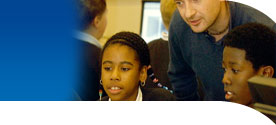



To make good progress pupils need continuity and opportunities for development across the key stages. To achieve this, curriculum planning at key stage 3 needs to:
During key stage 2, pupils use the number system more confidently. They move from counting reliably to calculating fluently with all four number operations. They always try to tackle a problem with mental methods before using any other approach. Pupils explore features of shape and space and develop their measuring skills in a range of contexts. They discuss and present their methods and reasoning using a wider range of mathematical language, diagrams and charts.
By the end of key stage 2, most pupils have extended their understanding of the number system to include integers, fractions and decimals. They approximate and estimate more systematically. Most are able to use patterns and relationships to explore simple algebraic ideas. They are able to apply their measuring skills in a range of contexts. They are able to draw inferences from data in practical activities and begin to recognise the difference between meaningful and misleading representations of data.
Pupils can explore and use a variety of resources and materials, including ICT. Pupils are encouraged to make decisions about when it is appropriate to use a calculator, and to use calculators effectively.
Pupils begin to use mathematics in other subjects.
The mathematics programme of study for key stage 3 builds on the knowledge, skills and understanding pupils acquire during key stage 2. During key stage 3, pupils focus on developing their understanding of the key concepts in mathematics and demonstrate increasing confidence and independence as they work with the key processes. They apply these to a broader range of familiar contexts, using a variety of resources outlined in the range and content section. Pupils consolidate and extend mental and written techniques for calculation. They are encouraged to use calculators efficiently and correctly and know when it is appropriate to use a particular form of technology. They encounter activities that develop chains of deductive reasoning and concepts of proof in algebra and geometry. Pupils develop their ability to visualise and analyse geometrical situations, working with them mentally and practically. They complete activities that address increasingly demanding problems and that require statistical, numerical or analytical approaches.
By the end of key stage 3, most pupils are able to use systematic methods to explore a situation (for example trying different values or looking at a simple case). Most are familiar with, and confident using, standard procedures for a range of calculations and problems, including ratio and proportion, and appreciate that algebra is an extension of number. Most pupils solve familiar and unfamiliar problems in a range of numerical, algebraic and graphical contexts. Most pupils appreciate the difference between evidence and proof and can use different techniques to work on a problem (for example working backwards and looking at simpler cases). Most are able to carry out practical work, draw inferences from data and consider how statistics are used in real life. Most pupils are able to relate findings to the original context, identifying whether they support or refute conjectures or hypotheses.
In key stage 4 pupils continue to build on the skills developed through the key concepts and key processes during key stage 3, applying these to a broader range of contexts through working within the additional scope outlined in the range and content section. They consolidate their understanding of basic mathematics, which will help them to tackle unfamiliar problems in the workplace and everyday life and develop the knowledge and skills they need in the future.
In representing pupils become more fluent in making connections between different areas of mathematics and its application in the world around them. They develop the confidence, flexibility and independence to solve unfamiliar problems and to use ICT appropriately.
In analysing pupils become increasingly proficient in calculating using mental written and ICT methods. They develop skills of algebraic manipulation and simplification and apply algebraic techniques to solve problems. Pupils use short chains of deductive reasoning, develop their own proofs, and begin to understand the importance of proof in mathematics. They learn to handle and manipulate large datasets through practical activities using a range of skills and techniques including sampling.
In interpreting and communicating pupils make connections between new situations and those they have met previously. They extend their use of mathematical vocabulary explaining their reasoning with increasing rigour. They understand and follow a short proof. Pupils see the importance of mathematics as an analytical tool for solving problems and learn to appreciate its unique power, using a range of forms to communicate findings to different audiences.